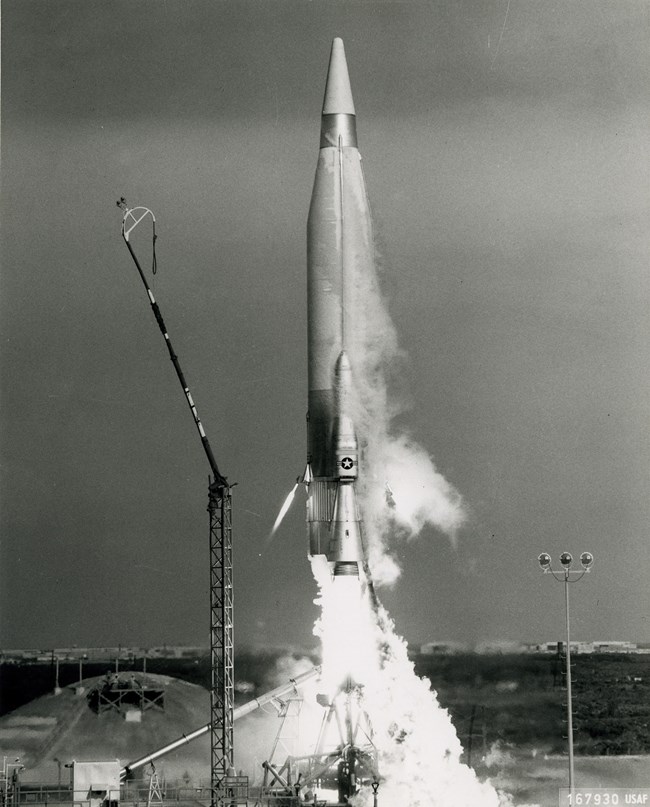Part of a series of articles titled Minuteman Missiles and the Nuclear Arms Race.
Previous: The American ICBM Program
Article

U.S. Air Force
The Western Development Division staff began its work by reviving a missile project that had originated shortly after World War II. In 1946, the Air Force had contracted with the Convair Corporation to design a long-range ballistic missile called the MX-774. Like many post-war missile projects, the MX-774 lost most of its government funding after only one year. But, instead of dropping the project, Convair Corporation continued working on its own, steadily advancing the state of missile technology. In 1951, the Air Force acknowledged these efforts by hiring the company to develop plans for a more advanced missile, called the Atlas.
The Atlas was essentially a highly evolved version of the German V-2 missile, which Germany had used against the Allies during the waning years of World War II. Like the V-2, the Atlas was powered by rocket engines that burned a mixture of liquid fuel and oxidizer. But while the V-2 had an effective range of only a few hundred miles, the Atlas had to deliver its payload to a target more than 5,000 miles away. Convair Corporation could have met this requirement by designing the Atlas as an enormous version of the V-2. Instead, Convair's engineers sought a more sophisticated solution. Realizing that a missile's range could be increased by reducing its weight, Convair equipped the Atlas with an innovative, ultra-light airframe. Convair assembled the missile from rings of paper-thin stainless steel, stacked together like stovepipes and welded at the seams to form cylinders. The cylinders were then inflated with nitrogen gas to give the missile its structural integrity.
By 1954, the Atlas was the Nation's most advanced ballistic missile. Nonetheless, the missile was years away from production. No prototype had been flight tested, and some skeptics feared that when Atlas's powerful engines were fired for the first time, the missile's thin-skinned airframe would buckle in on itself, leaving America's hopes for an ICBM lying on the launch pad like a gigantic ball of tin foil.
General Schriever and his staff were aware of these concerns. So while they proceeded with the Atlas program, they also looked for a backup. In October 1955, the Air Force contracted with the Glenn L. Martin Company to produce a new ICBM called the Titan. Like the Atlas, the Titan used liquid propellants, but its advanced two-stage design allowed for a conventional, and more reliable, airframe.
Still, America's missile program was hampered by funding problems. In 1956, Air Force Secretary Donald Quarles rejected the operational budget for the ICBM program, and proposed the elimination of either Atlas or Titan, which he considered redundant. That same year, the Air Force lost its most effective missile proponent when Assistant Secretary Trevor Gardner, the "Missile Czar," announced his retirement, citing continued cuts to his missile research and development budgets. Undeterred by Gardner's retirement, Quarles's austerity campaign continued into 1957 when the ballistic missile program was slashed by $200 million. In July, the Eisenhower administration initiated even more cost-saving measures, including cutting missile deliveries, lowering overtime rates, and delaying payments to contractors.
Part of a series of articles titled Minuteman Missiles and the Nuclear Arms Race.
Previous: The American ICBM Program
Last updated: October 20, 2020